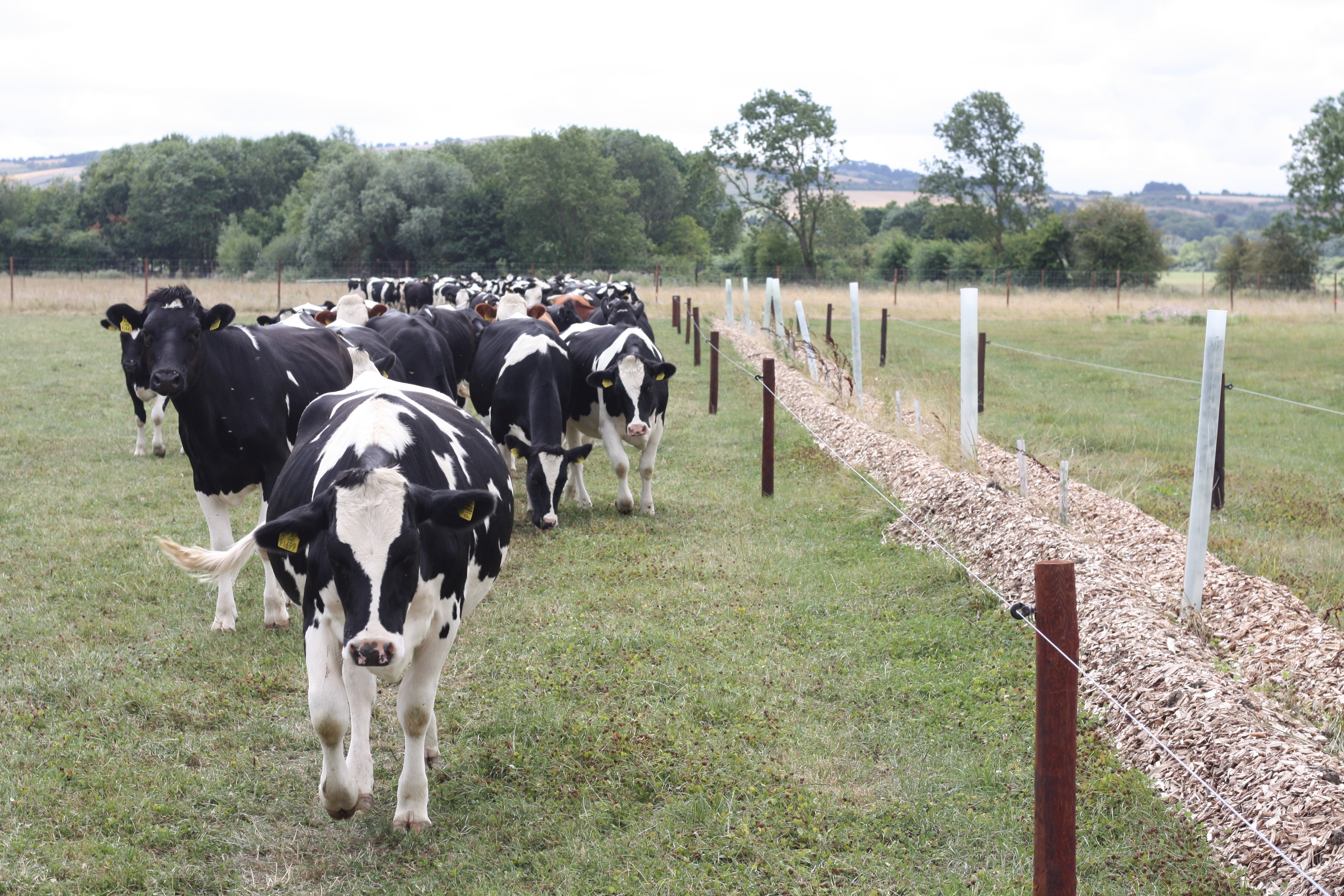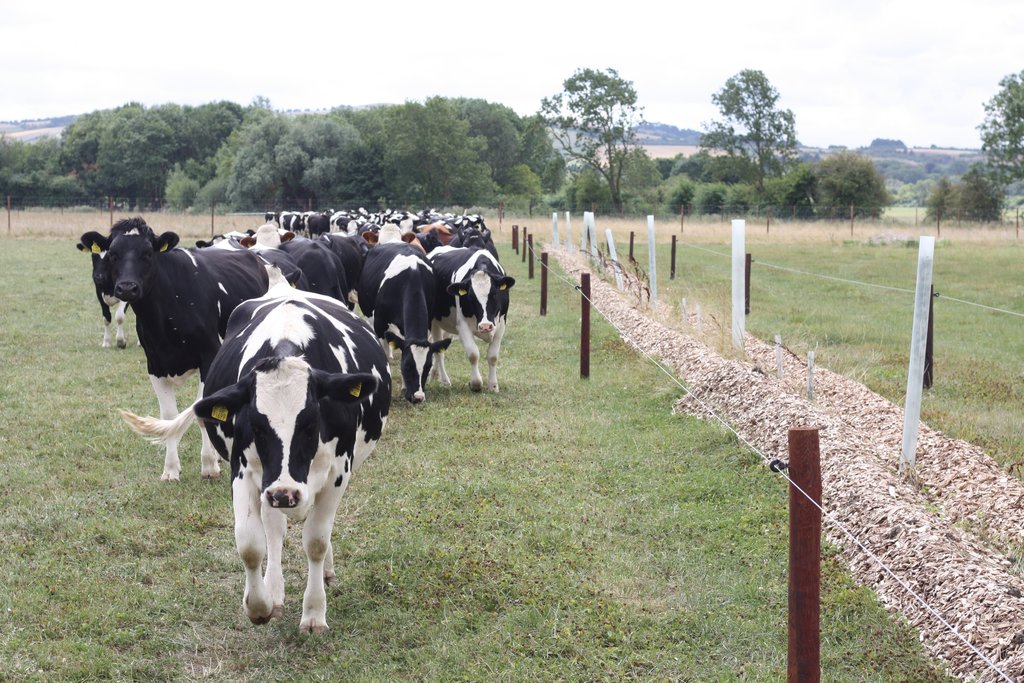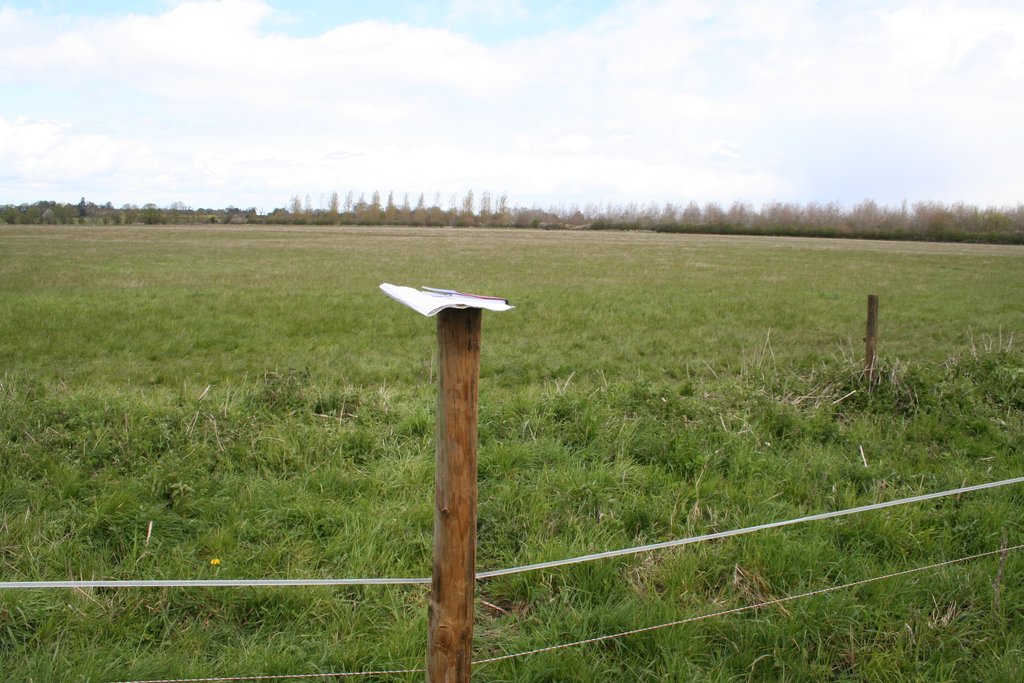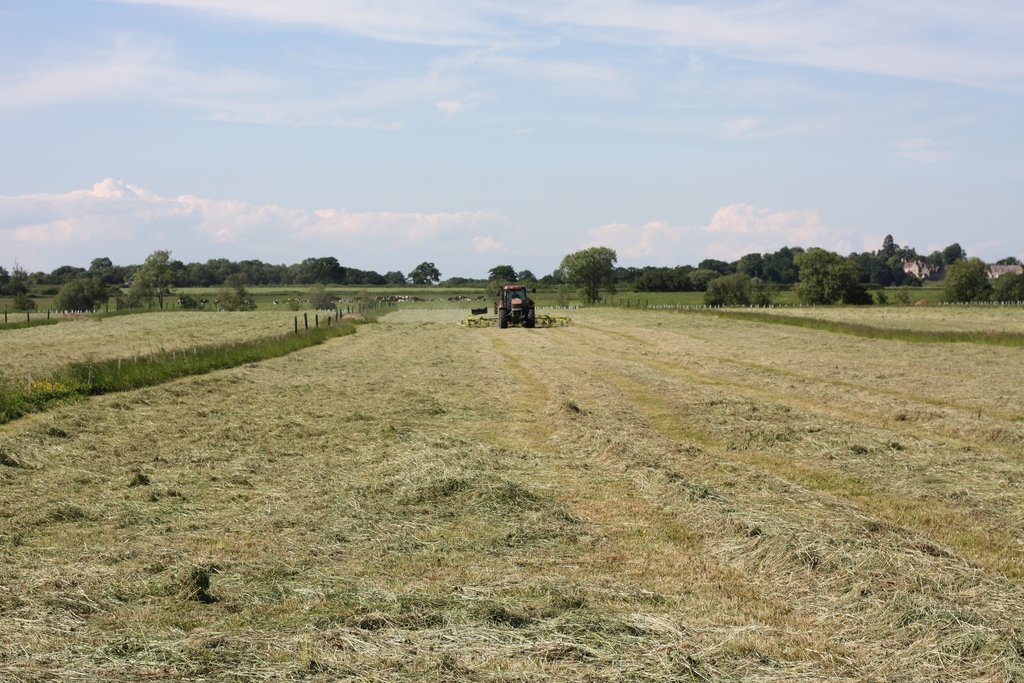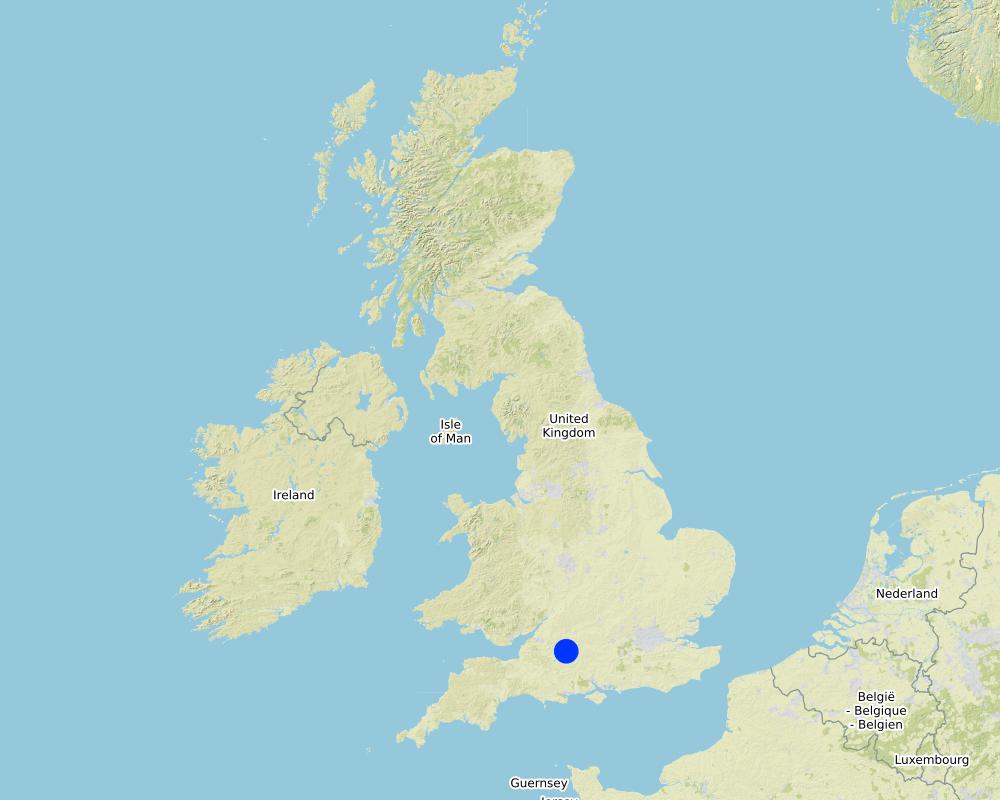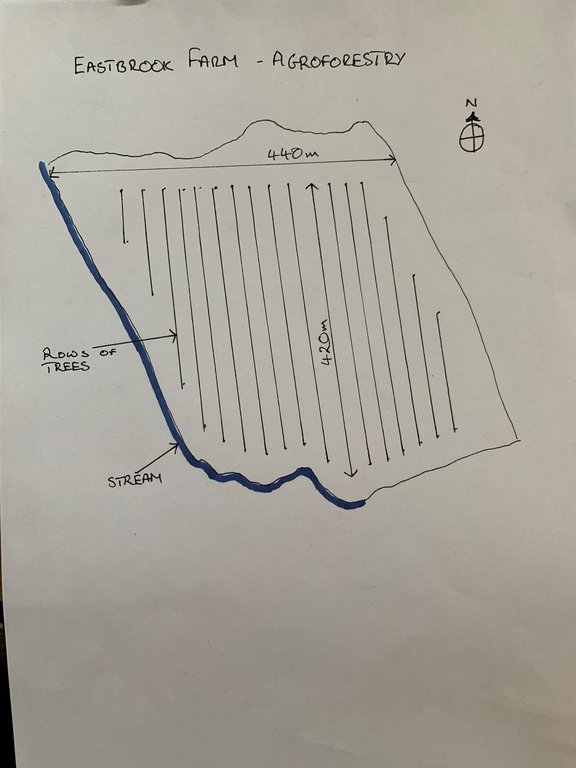Silvopastoral Agroforestry – Perry pears and timber with mob grazed young dairy stock [英国]
- 创建:
- 更新:
- 编制者: Alan Radbourne
- 编辑者: David Robinson, David Norris, Sabine Reinsch
- 审查者: Ursula Gaemperli, Rima Mekdaschi Studer
Silvopastoral Agroforestry – Perry pears and timber with mob grazed young dairy stock
technologies_5186 - 英国
查看章节
全部展开 全部收起1. 一般信息
1.2 参与该技术评估和文件编制的资源人员和机构的联系方式
关键资源人
SLM专业人员:
Raskin Ben
Soil Association
英国
土地使用者:
Browning Helen
Eastbrook Farm
英国
有助于对技术进行记录/评估的项目名称(如相关)
European Interreg project FABulous Farmers1.3 关于使用通过WOCAT记录的数据的条件
编制者和关键资源人员接受有关使用通过WOCAT记录数据的条件。:
是
1.4 所述技术的可持续性声明
这里所描述的技术在土地退化方面是否存在问题,导致无法被认为是一种可持续的土地管理技术?:
否
2. SLM技术的说明
2.1 技术简介
技术定义:
Silvopastoral Agroforestry in a natural farmed environment – This is an alley cropping system with rows of Perry pears and timber trees inter-planted with coppiced willow and alder. The pasture in between the rows is mob grazed with young dairy stock.
2.2 技术的详细说明
说明:
Background: The agroforestry system is part of a mixed farm of 630 hectares. 550 hectares are rented on a three generation tenancy. The farmer is the second generation. The trees are planted on the 80 hectares owned by the farmer. The annual rainfall for the region is approximatly 630mm per year with a typical temperate UK climate. The soil is heavy clay on a flat landscape.
The system: The field is 19 hectares. The trees are planted in rows which are 27 m apart. There is a main species in each row, planted at 10 m spacing. These are inter-planted with smaller trees, or species that will be coppiced/pollarded to maintain a small form. The main species are: Perry pear (a small pear that is a cross between Pyrus communis and its wild subsp. pyraster – used to make the alcoholic drink “Perry”). We have also some species planted for timber Quercus robur, Sorbus torminalis, Carpinus betula, Prunus avium. The inter-plant species are Salix various sp., Alnus glutinosa. These will be used either for animal fodder or for chipping and used as a mulch or for spreading on the land as soil health improver. There are also some Hippophae rhamnoides for human consumption. The alleys between the rows of trees are grazed by young dairy stock on a mob grazing rotational basis.
Aims: The aim is to improve soil and drainage in the field which is heavy clay. We hope to improve productivity but also have designed the system that we can grow crops in the future if we wanted to. The trees will also provide benefit to the cows through shelter and shade, and the inter-plants of willow and alder grow through diverse forage.
Tree protection: Fencing was our major challenge. There needed to be protection from the livestock but also from wildlife (in particular deer and hares). Our initial trial used individual guards and stakes but we have since fenced each side of each row with a single strand of electric fencing. This is working well.
Benefits: This is newly planted but already we are seeing improvement in the grass ley through our rotational grazing. Water quality into the nearby stream and infiltration improved and flooding should also improve. We have seen an immediate increase in wildlife with greater numbers of hares, raptors (including kestrels, red kites and buzzards), and butterflies. The farm manager likes the ability to mob graze, although the system was complicated to set up. It is too early to comment on further benefits at this stage.
2.3 技术照片
2.5 已应用该技术的、本评估所涵盖的国家/地区/地点
国家:
英国
区域/州/省:
South West
有关地点的进一步说明:
Wiltshire
具体说明该技术的分布:
- 均匀地分布在一个区域
如果技术均匀分布在一个区域,则指定覆盖的区域(单位为平方千米):
0.19
如果不知道精确的区域,请注明大致覆盖的区域:
- 0.1-1 平方千米
技术现场是否位于永久保护区?:
否
注释:
Eastbrook Farm, Bishopstone, Wiltshire, Helen Browning Organics
Latitude 51.566424, Longitude 1.668787
Map
×2.6 实施日期
注明实施年份:
2017
2.7 技术介绍
详细说明该技术是如何引入的:
- 通过土地使用者的创新
3. SLM技术的分类
3.1 该技术的主要目的
- 改良生产
- 结合其他技术保护流域/下游区域
- 减缓气候变化及其影响
- 创造有益的经济影响
- improve animal welfare
3.2 应用该技术的当前土地利用类型
同一土地单元内混合使用的土地::
是
具体说明混合土地使用(作物/放牧/树木):
- 林牧业

牧场
集约放牧/饲料生产:
- 改良牧场
动物类型:
- cattle - dairy and beef (e.g. zebu)
是否实行作物与牲畜的综合管理?:
是
如果是,请具体说明:
Silvo-pastoral system where pear trees grown in rows allowing for cattle pasture grazing in between.
产品和服务:
- 肉类
- 奶类
品种:
cattle - dairy and beef (e.g. zebu)
计数:
100

森林/林地
- 植树造林
植树造林:说明树种的起源和组成:
- 混交品种
植树造林类型:
- 温带大陆林人工林
- Perry Pear,Quercus robur, Sorbus torminalis, Carpinus betula, Prunus avium.
以上的树木是落叶树还是常绿树?:
- 落叶植物
产品和服务:
- 木材
- 水果和坚果
3.3 由于技术的实施,土地使用是否发生了变化?
由于技术的实施,土地使用是否发生了变化?:
- 是(请在技术实施前填写以下有关土地利用的问题)
同一土地单元内混合使用的土地::
否

牧场
集约放牧/饲料生产:
- 改良牧场
动物类型:
- cattle - dairy and beef (e.g. zebu)
是否实行作物与牲畜的综合管理?:
否
产品和服务:
- 肉类
- 奶类
品种:
cattle - dairy and beef (e.g. zebu)
计数:
100
3.4 供水
该技术所应用土地的供水:
- 雨养
注释:
Trees not irrigated. Cattle mainly by water troughs.
3.5 该技术所属的SLM组
- 农业林学
- 农畜综合管理
3.6 包含该技术的可持续土地管理措施

植物措施
- V1:乔木和灌木覆盖层

管理措施
- M2:改变管理/强度级别
3.7 该技术强调的主要土地退化类型

化学性土壤退化
- Cn:肥力下降和有机质含量下降(非侵蚀所致)

物理性土壤退化
- Pw:水浸
3.8 防止、减少或恢复土地退化
具体数量名该技术与土地退化有关的目标:
- 减少土地退化
4. 技术规范、实施活动、投入和成本
4.1 该技术的技术图纸
技术规范(与技术图纸相关):
The field has an area of 19 hectares with north to south rows of trees of up to 420m length and across a 440m field. The field is adjacent to stream and has no slope. The trees are planted in rows with a within row spacing of 10 m and between row spacing of 27 m . The main species planted is perry pear
作者:
Ben Raskin
日期:
21/10/2020
4.2 有关投入和成本计算的一般信息
具体说明成本和投入是如何计算的:
- 每个技术区域
注明尺寸和面积单位:
19 hectares
如果使用本地面积单位,注明转换系数为1公顷(例如1公顷=2.47英亩):1公顷=:
1 ha = 2.47 acres
其它/国家货币(具体说明):
British pound
如相关,注明美元与当地货币的汇率(例如1美元=79.9巴西雷亚尔):1美元=:
0.73
注明雇用劳工的每日平均工资成本:
Approx. £150
4.3 技术建立活动
| 活动 | 时间(季度) | |
|---|---|---|
| 1. | Trench dug with tillage machinery to plant each row of trees | Autumn |
| 2. | Tree standards (bought from tree nursery) planted by hand in trench spaces 2m apart | Winter |
| 3. | Fencing installed by hand as single strand electric along either side of each row of trees | Spring |
| 4. | Mulch added to base of trees using tractor to surpress weeds, provide fertiliser and keep moisture in soil | Spring |
4.4 技术建立所需要的费用和投入
如果您无法分解上表中的成本,请估算建立该技术所需要的总成本。:
14500.0
4.5 维护/经常性活动
| 活动 | 时间/频率 | |
|---|---|---|
| 1. | Mulching each year at base of trees | Yearly (first 3 years) |
| 2. | Strimming grass and weeds between trees where livestock are exluded from area by fencing | Yearly (first 5 years) |
| 3. | Light pruning or training by hand where required | Yearly (first 5 years) |
4.6 维护/经常性活动所需要的费用和投入(每年)
如果您无法分解上表中的成本,请估算维护该技术所需要的总成本。:
1500.0
4.7 影响成本的最重要因素
描述影响成本的最决定性因素:
Type of tree, type of fencing and weather related impacts.
5. 自然和人文环境
5.1 气候
年降雨量
- < 250毫米
- 251-500毫米
- 501-750毫米
- 751-1,000毫米
- 1,001-1,500毫米
- 1,501-2,000毫米
- 2,001-3,000毫米
- 3,001-4,000毫米
- > 4,000毫米
农业气候带
- 半干旱
5.2 地形
平均坡度:
- 水平(0-2%)
- 缓降(3-5%)
- 平缓(6-10%)
- 滚坡(11-15%)
- 崎岖(16-30%)
- 陡峭(31-60%)
- 非常陡峭(>60%)
地形:
- 高原/平原
- 山脊
- 山坡
- 山地斜坡
- 麓坡
- 谷底
垂直分布带:
- 0-100 m a.s.l.
- 101-500 m a.s.l.
- 501-1,000 m a.s.l.
- 1,001-1,500 m a.s.l.
- 1,501-2,000 m a.s.l.
- 2,001-2,500 m a.s.l.
- 2,501-3,000 m a.s.l.
- 3,001-4,000 m a.s.l.
- > 4,000 m a.s.l.
说明该技术是否专门应用于:
- 不相关
5.3 土壤
平均土层深度:
- 非常浅(0-20厘米)
- 浅(21-50厘米)
- 中等深度(51-80厘米)
- 深(81-120厘米)
- 非常深(> 120厘米)
土壤质地(表土):
- 细粒/重质(粘土)
土壤质地(地表以下> 20厘米):
- 细粒/重质(粘土)
表土有机质:
- 高(>3%)
5.4 水资源可用性和质量
地下水位表:
< 5米
水质请参考::
地下水
水的盐度有问题吗?:
否
该区域正在发生洪水吗?:
是
规律性:
偶然
关于水质和水量的注释和进一步规范:
Surface water flooding due to poor drainage, one aim of intervention is to help improve this.
5.5 生物多样性
物种多样性:
- 中等
栖息地多样性:
- 中等
5.6 应用该技术的土地使用者的特征
定栖或游牧:
- 定栖的
生产系统的市场定位:
- 混合(生计/商业)
非农收入:
- 低于全部收入的10%
相对财富水平:
- 平均水平
个人或集体:
- 个人/家庭
机械化水平:
- 机械化/电动
性别:
- 女人
- 男人
土地使用者的年龄:
- 中年人
5.7 应用该技术的土地使用者使用的平均土地面积
- < 0.5 公顷
- 0.5-1 公顷
- 1-2 公顷
- 2-5公顷
- 5-15公顷
- 15-50公顷
- 50-100公顷
- 100-500公顷
- 500-1,000公顷
- 1,000-10,000公顷
- > 10,000公顷
这被认为是小规模、中规模还是大规模的(参照当地实际情况)?:
- 大规模的
注释:
The agroforestry system is part of a mixed farm of 630 hectares
5.8 土地所有权、土地使用权和水使用权
土地所有权:
- 个人,未命名
土地使用权:
- 租赁
用水权:
- 租赁
土地使用权是否基于传统的法律制度?:
是
具体说明:
550 hectares rented, 80 hectares owned by the farmer
5.9 进入服务和基础设施的通道
健康:
- 贫瘠
- 适度的
- 好
教育:
- 贫瘠
- 适度的
- 好
技术援助:
- 贫瘠
- 适度的
- 好
就业(例如非农):
- 贫瘠
- 适度的
- 好
市场:
- 贫瘠
- 适度的
- 好
能源:
- 贫瘠
- 适度的
- 好
道路和交通:
- 贫瘠
- 适度的
- 好
饮用水和卫生设施:
- 贫瘠
- 适度的
- 好
金融服务:
- 贫瘠
- 适度的
- 好
6. 影响和结论性说明
6.1 该技术的现场影响
社会经济效应
生产
饲料生产
注释/具体说明:
Slight improvement in productivity of grassland due to rotational grazing between the trees.
产品多样性
注释/具体说明:
Currently still too early for full pear harvest, yet in time the return with product diversification will be of great benefit to farm diversification and sustainability.
收入和成本
收入来源的多样性
注释/具体说明:
Currently still too early for full pear harvest, yet in time the return with product diversification will be of great benefit to farm diversification and sustainability.
社会文化影响
娱乐机会
注释/具体说明:
Visitors coming to learn about Agroforestry has provided an opportunity to engage the interested general public and share knowledge.
生态影响
减少气候和灾害风险
洪水影响
注释/具体说明:
Slight reduction in standing water during periods of high rainfall
6.2 该技术的场外影响已经显现
对场外影响(测量)的评估进行具体说明:
N/A
6.3 技术对渐变气候以及与气候相关的极端情况/灾害的暴露和敏感性(土地使用者认为的极端情况/灾害)
渐变气候
渐变气候
| 季节 | 增加或减少 | 该技术是如何应对的? | |
|---|---|---|---|
| 季节性温度 | 夏季 | 增加 | 好 |
| 季雨量 | 夏季 | 增加 | 好 |
6.4 成本效益分析
技术收益与技术建立成本相比如何(从土地使用者的角度看)?
短期回报:
中性/平衡
技术收益与技术维护成本/经常性成本相比如何(从土地使用者的角度看)?
短期回报:
中性/平衡
注释:
Technology very recently implemented so cost-benefit is still unknown. Currnetly not viewed negitivly, yet benefits are still to be understood.
6.5 技术采用
- 单例/实验
在所有采用这项技术的人当中,有多少人是自发的,即未获得任何物质奖励/付款?:
- 91-100%
6.6 适应
最近是否对该技术进行了修改以适应不断变化的条件?:
否
6.7 该技术的优点/长处/机会
| 土地使用者眼中的长处/优势/机会 |
|---|
| Change in grazing regime from large pasture to rotational grazing between tree lines has additional benefits for improved pasture and animal wealfare with less requirement to worm using antibiotics. |
| Initial observations of improved water infiltration due to better infiltration by trees rooting system |
| 编制者或其他关键资源人员认为的长处/优势/机会 |
|---|
| Future opportunity of land and business diversification |
| Increase in biodiversity evident already and would expect further improvements. |
6.8 技术的弱点/缺点/风险及其克服方法
| 土地使用者认为的弱点/缺点/风险 | 如何克服它们? |
|---|---|
| Tree loss due to weather extremes (i.e. loss of young tree stock in 2018 summer drought) | Mulching, irrigation, earlier planting, improved placement of tree stock on edge of sub-soil slot where less soil drying occurs compared to centre of slot. |
| Perenial weed control poor using just wood chip mulch | Increased strimming management of the growth around trees where livestock cannot reach due to fencing. |
| Time investment against other commitments (i.e. priority of broader farm systems when attention to new technology is required) | Forward planning and improved communcation between the farm team is vital to ensure a sufficient amount of time is provided for attending to and learning about a new technology. |
| 编制者或其他关键资源人员认为的弱点/缺点/风险 | 如何克服它们? |
|---|---|
| Overall costs against short-term return | Secure funding to enable longer-term return. |
7. 参考和链接
7.1 信息的方法/来源
- 与土地使用者的访谈
1
- 与SLM专业人员/专家的访谈
1
(现场)数据是什么时候汇编的?:
08/10/2020
注释:
Ongoing discussions with farmer and agroforestry expert overseeing the project have developed this SLM data input. Date of last meeing to finalise information listed above.
链接和模块
全部展开 全部收起链接
无链接
模块
无模块


